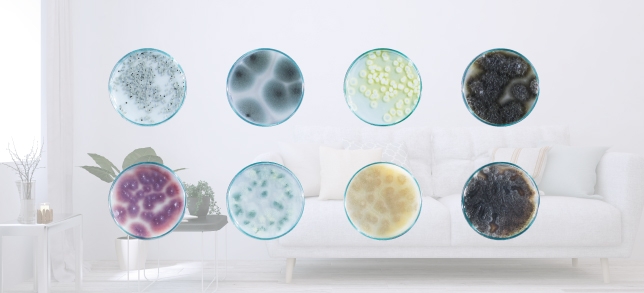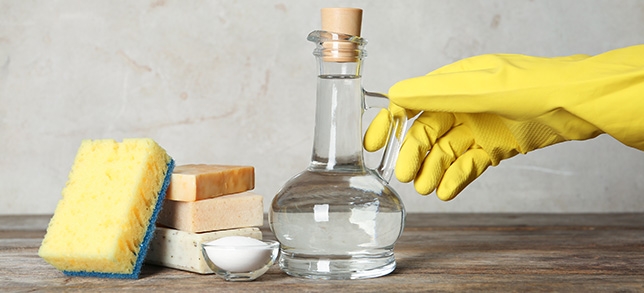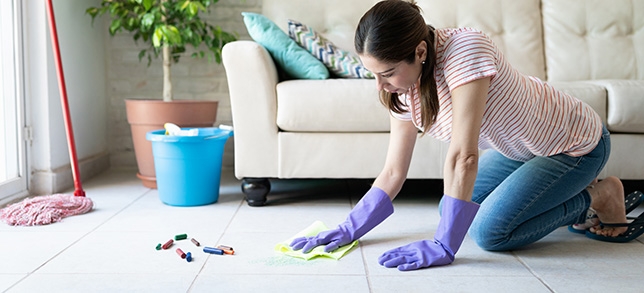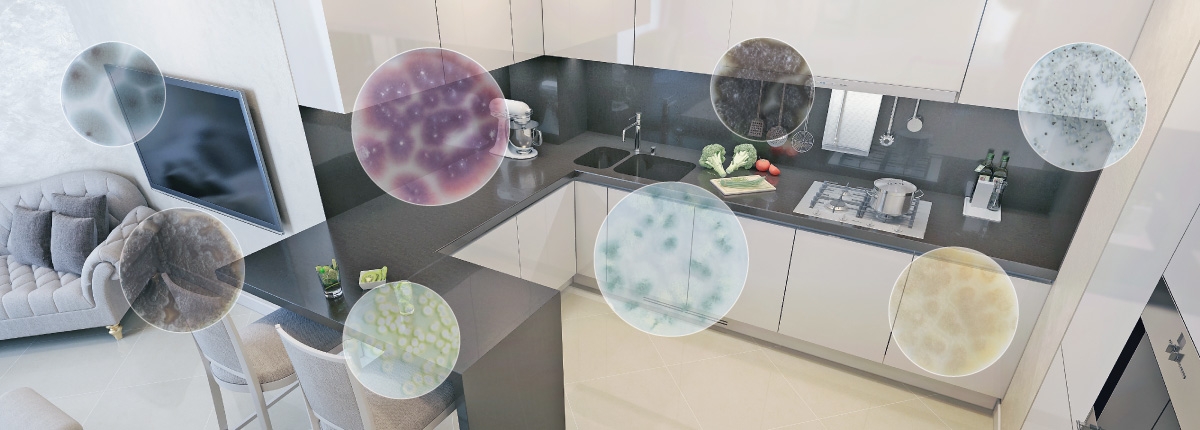How to get rid of mould in every corner of
your house
Table of Contents
● What is mould?
● What causes mould in your house?
● How to prevent mould
● What to do if you find mould in your house
● The bathroom and kitchen
● Walls, ceilings and flooring
● How nanoe™X technology can inhibit mould in your house
Are you suffering with a mould problem in your house?
It’s not uncommon – it can often make an unwelcome appearance. Particularly in the rainy months of the year.
And it can be anywhere in the home. From your ceilings, to your bathroom, to your kitchen.
In this post, we’re going to take you through the details – and most importantly, how to get rid of mould.
First, what is mould?
Simply put, mould is a form of fungus that breaks down dead organic material. Typically, it appears in damp or humid conditions, so our homes are the perfect place for it to grow. They offer moisture, warm air and materials for it to feed on, such as wallpaper or carpet.

The types of mould that you’re most likely to find in your house are:
● Cladosporium - a mould that’s mostly found on the outside of buildings.
● Fusarium - a highly dangerous mould that typically affects soil and plants.
● Aspergillus - one of the most common moulds whose spores you can find in any environment.
● Eurotium - a type of soil-borne fungus that can be most commonly found in the floor, on carpets and in mattress dust.
● Penicillium - a common mould that thrives both inside and outside of the home.
● Mucor - a mould that’s mostly found in moist and damp habitats.
● Alternia - a mould that’s often responsible for leaf spots and diseases on trees and bushes.
● Stachybotrys - a greenish-black mould that can grow on materials such as fiberboard.
After finding out what type of mould you’re dealing with – the first step to getting rid of it is to know what’s causing it.
So, what causes mould in your house?
Mould is caused by three main culprits: moisture, temperature, and nutrients.
Let’s look at each in turn:
Moisture in your home can be a result of leaking pipes, rising damp from basements or ground floors, or even rain seeping in due to roof or window damage.
Temperature plays a big part in mould growth. Areas with high humidity are the perfect breeding grounds for mould, especially when they are paired with a temperature between 21 and 32 degrees celsius - the optimal level for mould growth to flourish.
Mould needs nutrients to survive. In essence these are materials that it can digest – and strangely it can digest a high quantity. In fact, it can digest virtually any natural organic matter (containing carbon) including things such as dust, so it’s almost impossible for you to deprive it of food. But as well as natural materials, mould can grow on synthetic materials such as paints, adhesives and textiles.
How to prevent mould
Luckily there are ways to prevent mould before it even arises.
● Keep humidity levels in your home as low as you can all day long. Bear in mind, the humidity at which mould growth is likely to occur is similar to the humidity that people feel comfortable in. So controlling humidity with an air conditioner or dehumidifier will help you keep the level low.
● Make sure that the air in your home flows freely. Two easy ways of doing this are to use exhaust fans that vent outside your home – and also using a clothes dryer which does the same.
● Have a leak in your home? Fix it as soon as possible so mould doesn’t have the moisture necessary to thrive.
● Add mould inhibitors to paints before you start painting, these can be found at the majority of DIY stores.
● Clean bathrooms with mould-killing products, so if there’s a speck you can’t see, it will be eradicated.
But with all the best will in the world, sometimes mould can occur anyway.
What to do if you find it in your house (and how to get rid of mould)
You might be asking “Can I get rid of mould myself?”
You can, but it’s important to take precautions when removing mould, as it can be toxic and harmful to your health.
Make sure you wear a face mask, protective eye goggles and a face mask to ensure you’re covered and out of harm’s way.

Let’s break it down place by place
As mould is growing in different conditions depending on the area in your house, you need to treat each place differently.
The bathroom and kitchen
As mould is growing in different conditions depending on the area in your house, you need to treat each place differently.
● Vinegar is a great option for killing bathroom or kitchen mould. It has a strong smell, but it doesn’t have the toxic elements of bleach. Pour it straight onto the spores or use a spray bottle and leave it for 30 minutes before wiping away.
● Sodium borate is a natural insecticide and fungicide that mixes sodium to elaborate decahydrate with water. You can buy it from most stores.
● Bleach should be your last option, as it’s a toxic substance. Always make sure you mix it with water at a ratio of 1:10 and rinse well after.

Walls, ceilings and flooring
● Make a solution of chlorine bleach and water.
This will usually be one-part bleach to three parts water – or you can simply buy a household detergent that has bleach as an active ingredient.
● Scrub the mouldy area
Using a stiff-bristled brush, scrub the blackened area until the mould has come loose.
● Rinse thoroughly and dry
Rinse with a cloth and water and leave to dry naturally.
Note: are you finding mould on your household appliances or fabrics? They can have the same treatment.

How nanoe™X technology can inhibit mould growth in your house
Of course, mould can get into the air as well. Spores are carried in the air and may cause health problems if inhaled by people who are sensitive or allergic to them.
Panasonic air conditioners come with nanoe™ X technology and operate invisibly in the air, so that mould spores are easily and quickly broken down. This means that the source of mouldy smells decreases significantly.
Your health – and your family’s health – needs to come first.








